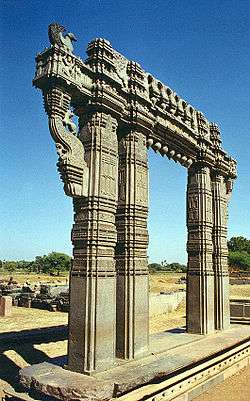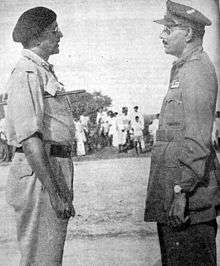History of Telangana
| Part of a series on the |
| Telangana Culture |
|---|
 |
|
People |
|
Languages |
|
Cuisine |
|
Arts and Crafts • Music of Telangana • Shadow Puppets of Telangana |
|
Literature |
|
Tourism |
|
Cinema |
|
|
| Part of a series on |
| Telangana |
|---|
|
| History and Kingdoms |
The history of Telangana,[1] located in the Deccan region, includes its governance by many rulers. It was ruled by the Satavahana dynasty (230 BCE to 220 CE), the Telinga Kakatiya Dynasty (1083–1323), the Musunuri Nayaks (1326–1356) the Delhi Sultanate, the Bahmani Sultanate (1347–1509) and Vijayanagara Empire (1509–1529). Later, the Telangana region became part of the Golconda Sultanate (1529–1687).
On 2 June 2014, Telangana became the 29th state of India, consisting of the ten districts, with Hyderabad as its capital.[2] The city of Hyderabad will continue to serve as the joint capital for Andhra Pradesh and the successor state of Telangana for a period of ten years.
Telangana history and the history of Andhra Pradesh are very similar as both states share the same language and culture.[3]
Early History
Satavahana Dynasty
The Satavahanas rose to a political power, after the fall of the Mauryan Empire. Koti Lingala seems to be one of the 30 cities of Satavahana dynasty.[4] Excavations revealed brick wells, coins belonging to pre-Satavahana period, Gobhada and Samagopa. It is believed that the place is the site of hermitage of sage Bhavari.[5] Several coins of Simukha, the founder of the Satavahana dynasty, and those of other early rulers like Kanha and Satakarni I were found.[6]
The Deccan, during this period was an emporium of inland and maritime trade. The region between the rivers of Godavari and Krishna was full of ports and throbbing with activity. There was plentiful of currency to facilitate trade and the people entered upon a period of great industrial, commercial and maritime activity. Buddhism flourished throughout the period and the rulers were also devoted to Vedic ritualism. They constructed several Buddhist Stupas, Viharas and Chaityas. Satavahanas were able rulers and loved literacy and architecture. The 17th ruler of this dynasty, Hāla was a great poet and his “Gathasaptasati” in Prakrit was well received by all. Gunadhya, the minister of Hala was the author of “Brihatkadha”. According to Matsya Purana, there were 29 rulers of this dynasty. They ruled over for about 456 years, from the 2nd century BC to the 2nd century AD. The empire included most of the southern peninsula and some southern parts of the present Indian states of Maharashtra, Orissa and Madhya Pradesh. The court language used by the Satavahanas was Prakrit.
The decline and fall of the Satavahana Empire left the state in a political chaos. Local rulers as well as invaders tried to carve out small kingdoms for themselves and to establish many dynasties. Such instability continued to prevail until the rise of the Western Chalukyas.
Kakatiyas
The 12th and 13th centuries saw the emergence of the Kakatiya dynasty.[7] At first they were feudatories of the Western Chalukyas of Kalyani, ruling over a small territory near Warangal. A ruler of this dynasty, Prola II (1110–1158), extended his sway to the south and declared his independence. His successor Rudra (1158–1195) pushed the kingdom to the east up to the Godavari delta. He built Warangal Fort to serve as a second capital and faced the invasions of the Seuna Yadavas of Devagiri. The next ruler, Mahadeva, extended the kingdom to the coastal area. Ganapati Deva succeeded him in 1199. He was the greatest of the Kakatiyas and the first after the Satavahanas to bring almost the entire Telugu area under one unified empire. Ganapati put an end to the rule of the Velanati Cholas in 1210 and extended his empire to Anakapalle in the north. The most prominent ruler in this dynasty was Rani Rudrama Devi (1262–1289), one of the few queens in Indian history. An able fighter and ruler, Rudrama defended the kingdom against the Cholas and the Seuna Yadavas, earning their respect. She remains one of the few female rulers in South India at any period. On the death of Rudrama at the beginning of 1290, her grandson Prataparudra, whom she adopted as her son and heir apparent on the advice of her father Ganapatideva, ascended the throne. Prataparudra had to fight battles throughout his reign against either internal rebels or external foes. Prataparudra expanded his borders to the west to Raichur and in the south to Ongole and the Nallamala Hills, whilst introducing many administrative reforms, some of which were also later adopted in the Vijayanagar empire.
_and_Ruins.jpg)
The Kakatiyas are known through their famous architecture such as Warangal Fort, Ramappa Temple, Thousand Pillar Temple.[8]
The Kakatiya dynasty faced Muslim onslaughts beginning in 1310 and came under the control of the Delhi Sultanate in 1323. The region enjoyed a brief period of 50 years of independence under the Musunuri Nayaks, who rebelled and liberated Telugu land from the rule of Delhi.
Telangana Rebellion

In late 1945, there started a peasant uprising in Telangana area, led by communists also known as The Telangana Rebellion Vetti Chakiri Udyamam or Telangana Raithanga Sayudha Poratam. The communists drew their support from various quarters. Among the poor peasants, there were grievances against the jagirdari system, which covered 43% of land holding. Initially they also drew support from wealthier peasants who also fought under the communist banner, but by 1948, the coaliation had disintegrated. According to the Indian intelligence Bureau Deputy Director, the social and economic programs of the communists were "positive and in some cases great... The communists redistributed land and livestock, reduced rates, ended forced labour and increased wages by one hundred percent. They inoculated the population and built public latrines; they encouraged women’s organisations, discouraged sectarian sentiment and sought to abolish untouchability."
Initially, in 1945, the communists targeted zamindars and deshmukhs, but soon they launched a full-fledged revolt against the Nizam. Starting mid-1946, the conflict between the Razakars and the communists became increasingly violent, with both sides resorting to increasingly brutal methods. The Razakars cordoned off villages, captured suspected communists en masse and engaged in ‘absolutely indiscriminate and organised' (according to one Congressman) looting and massacres. According to an Indian govt. pamphlet, the communists had killed about 2,000 people by 1948.[9]
Post-independence
India became independent from the United Kingdom in 1947. The Muslim Nizam of Hyderabad wanted to retain his independence from India, but was forced to cede his state to India in 1948 to form Hyderabad State.
Indian integration of Hyderabad
Operation Polo, the code name of the Hyderabad "Police Action"[10][11] was a military operation in September 1948 in which the Indian Armed Forces invaded the State of Hyderabad and overthrew its Nizam, annexing the state into the Indian Union.
At the time of the Partition of India, the princely states of India, who in principle had self-government within their own territories, were subject to subsidiary alliances with the British, giving them control of their external relations. In the Indian Independence Act 1947 the British abandoned all such alliances, leaving the states with the option of opting for full independence. However, by 1948 almost all had acceded to either India or Pakistan. One major exception was that of Hyderabad, where the Nizam, Osman Ali Khan, Asif Jah VII, a Muslim ruler who presided over a largely Hindu population, chose independence and hoped to maintain this with an irregular army recruited from the Muslim aristocracy, known as the Razakars.[12]:224 The Nizam was also beset by the Telangana uprising, which he was unable to subjugate.[12]:224
The Indian government, anxious to avoid what it termed a Balkanization of what had been the Indian Empire, was determined on the integration of Hyderabad into the new Indian Union.[12]:223 Amidst atrocities by the Razakars, the Indian Home Minister Sardar Patel decided to annex Hyderabad[13] in what was termed a "police action". The operation itself took five days, in which the Razakars were defeated easily.
The operation led to massive violence on communal lines. The Indian prime minister Jawaharlal Nehru appointed a commission known as the Sunderlal Committee. Its report, which was not released until 2013, concluded that "as a conservative estimate...27,000 to 40,000 people had lost their lives during and after the police action."[14]

References
- ↑ "Telangana History PDF". Bookinfo.
- ↑ "Notification" (PDF). The Gazette of India. Government of India. 4 March 2014. Retrieved 4 March 2014.
- ↑ "A brief history of Telangana". Business Standard Ltd. New Delhi. 1 June 2014. Retrieved 20 July 2014.
- ↑ Protection wall for Koti Lingala temple
- ↑ Buddhism and Modern Society, ed. by Y. S. Rao and G.B. Naik, Deep & Deep Publications; 2008, p. 293
- ↑ Indian History, Krishna Reddy; Tata-McGraw Hill Education, New Delhi, 2011. p. A-250
- ↑ Kakatiya dynasty
- ↑ Kakatiyas
- ↑ Sherman, Taylor C. (2007). "The integration of the princely state of Hyderabad and the making of the postcolonial state in India, 1948 - 56"
- ↑ "Hyderabad Police Action". Indian Army. Retrieved 2014-09-13.
- ↑ "Hyderabad on the Net". Retrieved 12 September 2014.
- 1 2 3 Barbara D. Metcalf; Thomas R. Metcalf (2006). A Concise History of India (2nd ed.). Cambridge University Press. ISBN 978-0521682251.
- ↑ Kate, P. V., Marathwada Under the Nizams, 1724-1948, Delhi: Mittal Publications, 1987, p.75